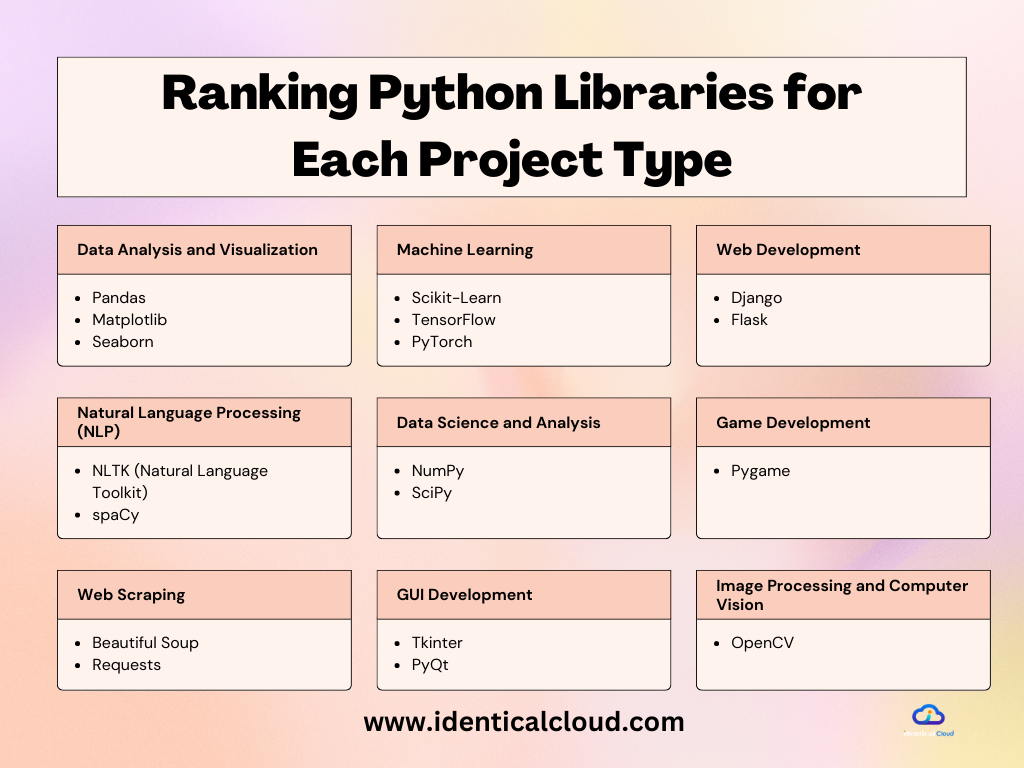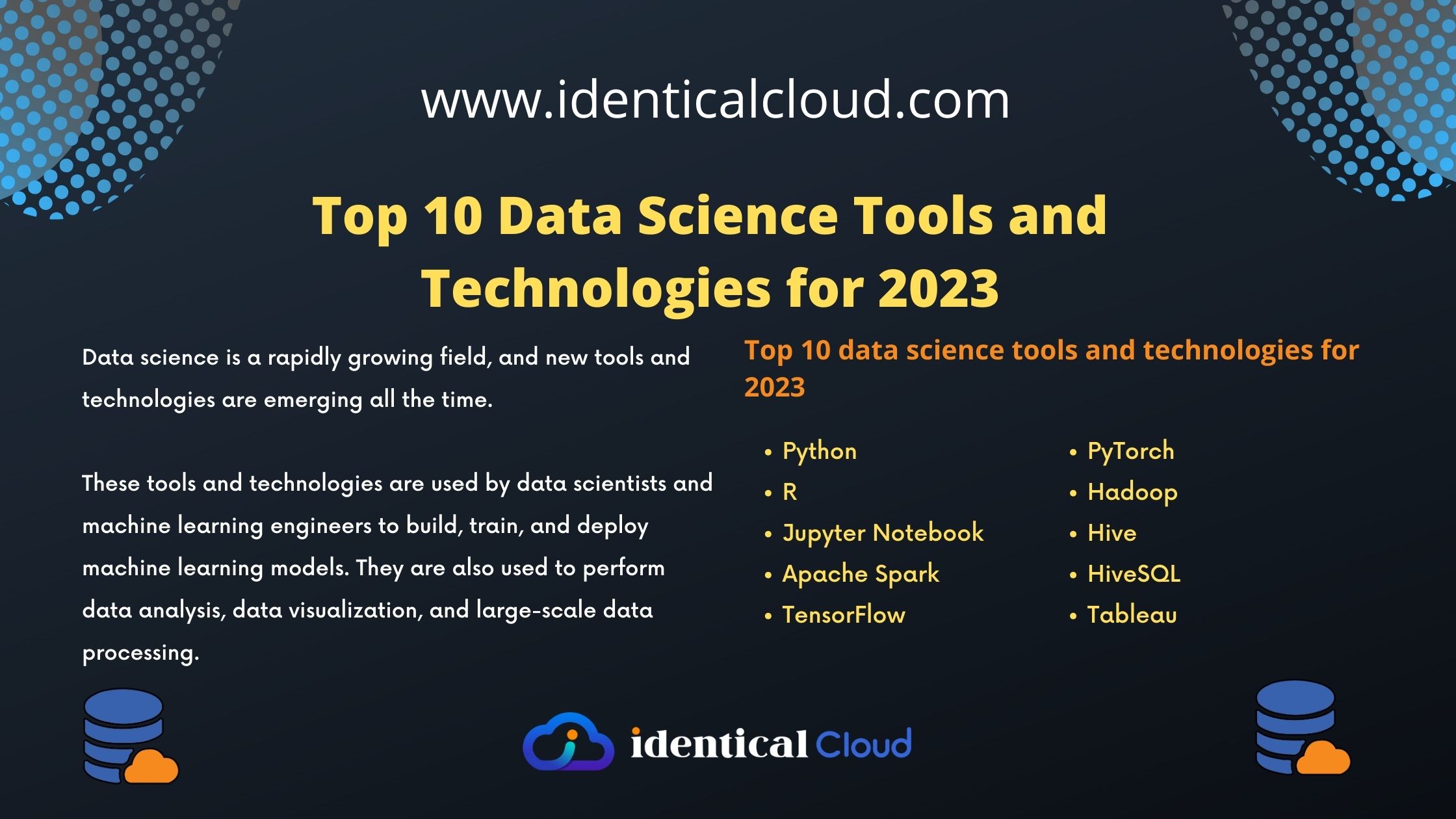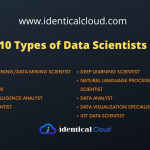
Ranking Python Libraries for Each Project Type
Ranking Python Libraries for Each Project Type
Python, with its versatility and extensive library ecosystem, has become a staple in the world of programming. With countless libraries available, each designed to tackle specific tasks, choosing the right ones for your project can be a daunting task.
Understanding the Power of Python Libraries
Python libraries are pre-written sets of code that provide a range of functions and tools to simplify and expedite development. They cover everything from data analysis and machine learning to web development and graphics. Properly selecting and utilizing libraries can significantly enhance your project’s efficiency, functionality, and overall success.
Here we’ll provide a detailed ranking of Python libraries for various project types, helping you make informed decisions and streamline your development process.
Ranking Python Libraries by Project Type
1. Data Analysis and Visualization:
- Pandas:
Widely used for data manipulation and analysis, Pandas offers powerful tools for working with structured data.
Pandas is a Python library for data manipulation and analysis. It is one of the most popular Python libraries for data science. Pandas provides a high-level interface for working with tabular data. It is a powerful tool for data scientists who need to clean, manipulate, and analyze data.
Pandas is built on top of NumPy, which is a library for scientific computing in Python. NumPy provides a high-performance multidimensional array object and tools for working with arrays. Pandas uses NumPy arrays to store data, which makes it very fast and efficient.
- Matplotlib:
An essential library for creating static, interactive, and animated visualizations in Python.
Matplotlib is a Python library for plotting graphs and charts. It is one of the most popular Python libraries for data visualization. Matplotlib can be used to create a variety of plots, including line charts, bar charts, pie charts, and scatter plots.
Matplotlib is built on top of NumPy, which is a library for scientific computing in Python. NumPy provides a high-performance multidimensional array object and tools for working with arrays. Matplotlib uses NumPy arrays to store data, which makes it very fast and efficient.
- Seaborn:
Built on top of Matplotlib, Seaborn provides an easier way to create appealing statistical graphics.
Seaborn is a Python library for statistical data visualization. It is built on top of Matplotlib, but it provides a high-level interface for creating attractive and informative plots. Seaborn is a popular choice for data visualization in Python, and it is used by data scientists, analysts, and researchers.
2. Machine Learning:
- Scikit-Learn:
Offers a comprehensive set of tools for machine learning, including classification, regression, clustering, and more.
Scikit-Learn is a Python library for machine learning. It is one of the most popular machine learning libraries in Python, and it is used by data scientists, engineers, and researchers. Scikit-Learn provides a variety of machine learning algorithms, including linear regression, logistic regression, support vector machines, and random forests.
Scikit-Learn is built on top of NumPy and SciPy, which are libraries for scientific computing in Python. NumPy provides a high-performance multidimensional array object and tools for working with arrays. SciPy provides a variety of numerical algorithms, including linear algebra, optimization, and statistics.
- TensorFlow:
Developed by Google, TensorFlow is a popular library for building and training neural networks.
TensorFlow is an open-source software library for numerical computation using data flow graphs. It is used for machine learning and artificial intelligence applications. TensorFlow was originally developed by researchers and engineers at Google Brain, and it is now used by a wide range of companies and organizations around the world.
TensorFlow is a powerful library for machine learning. It can be used to train and deploy a variety of machine learning models, including deep learning models. TensorFlow is also very versatile, and it can be used for a variety of tasks, such as image recognition, natural language processing, and speech recognition.
- PyTorch:
Known for its dynamic computation graph, PyTorch is favored by researchers and developers for deep learning tasks.
PyTorch is an open-source machine learning library based on the Torch library. It is used for applications such as computer vision and natural language processing. PyTorch is a popular choice for deep learning research and development, as it provides a flexible and expressive programming interface.
PyTorch is a dynamic library, which means that it can be used to create both imperative and declarative programs. This makes it a versatile tool for a variety of machine learning tasks.
3. Web Development:
- Django:
A high-level web framework that encourages rapid development and clean, pragmatic design.
Django is a free and open-source web framework written in Python. It is a popular choice for developing web applications, as it provides a high level of abstraction and a well-defined set of APIs. Django is known for its scalability, security, and reliability.
Django is a full-stack framework, which means that it provides everything you need to develop a web application, from the database to the user interface. This makes it a good choice for beginners, as it eliminates the need to learn multiple technologies.
- Flask:
A lightweight micro web framework, ideal for small to medium-sized web applications.
Flask is a microframework for Python web development. It is a lightweight framework that is easy to learn and use. Flask is a good choice for web applications that do not need a lot of features or complexity.
Flask is a minimalist framework, which means that it does not provide a lot of features out of the box. This can be a good thing for beginners, as it allows you to focus on the features that your application needs. However, it can also be a challenge for developers who are used to more full-featured frameworks.
4. Natural Language Processing (NLP):
- NLTK (Natural Language Toolkit):
Offers libraries, resources, and tools for building Python programs to work with human language data.
NLTK (Natural Language Toolkit) is a Python library for natural language processing. It is one of the most popular NLP libraries in Python, and it is used by students, researchers, and developers around the world. NLTK provides a wide range of features for NLP, including:
- Tokenization: NLTK can be used to tokenize text, which means that it can break text down into words, phrases, and sentences.
- Stemming: NLTK can be used to stem words, which means that it can remove common prefixes and suffixes from words.
- Lemmatization: NLTK can be used to lemmatize words, which means that it can find the base form of a word.
- Part-of-speech tagging: NLTK can be used to tag words with their part of speech, such as noun, verb, adjective, and adverb.
- Named entity recognition: NLTK can be used to recognize named entities in text, such as people, organizations, and places.
- Text classification: NLTK can be used to classify text into categories, such as news, sports, and entertainment.
- Sentiment analysis: NLTK can be used to analyze the sentiment of text, such as whether it is positive, negative, or neutral.
NLTK is a powerful and versatile library for NLP. It is a must-have library for any Python developer who needs to work with text data.
- spaCy:
A fast and efficient library for NLP, spaCy excels in part-of-speech tagging, named entity recognition, and more.
spaCy is a Python library for natural language processing. It is one of the most popular NLP libraries in Python, and it is used by students, researchers, and developers around the world. spaCy is known for its speed, accuracy, and ease of use.
spaCy provides a wide range of features for NLP, including:
- Tokenization: spaCy can be used to tokenize text, which means that it can break text down into words, phrases, and sentences.
- Stemming: spaCy can be used to stem words, which means that it can remove common prefixes and suffixes from words.
- Lemmatization: spaCy can be used to lemmatize words, which means that it can find the base form of a word.
- Part-of-speech tagging: spaCy can be used to tag words with their part of speech, such as noun, verb, adjective, and adverb.
- Named entity recognition: spaCy can be used to recognize named entities in text, such as people, organizations, and places.
- Dependency parsing: spaCy can be used to parse text, which means that it can find the relationships between words in a sentence.
- Text classification: spaCy can be used to classify text into categories, such as news, sports, and entertainment.
- Sentiment analysis: spaCy can be used to analyze the sentiment of text, such as whether it is positive, negative, or neutral.
spaCy is a powerful and versatile library for NLP. It is a must-have library for any Python developer who needs to work with text data.
5. Data Science and Analysis:
- NumPy:
The foundation for numerical computations in Python, NumPy provides support for large, multi-dimensional arrays and matrices.
NumPy is a Python library for scientific computing. It is one of the most popular Python libraries, and it is used by students, researchers, and developers around the world. NumPy provides a high-performance multidimensional array object, as well as a wide range of mathematical functions for working with arrays.
NumPy arrays are very fast and efficient, which makes them ideal for scientific computing. NumPy also provides a wide range of mathematical functions for working with arrays, such as:
- Linear algebra: NumPy provides functions for performing linear algebra operations on arrays, such as matrix multiplication and solving systems of linear equations.
- Statistical functions: NumPy provides functions for performing statistical operations on arrays, such as calculating standard deviation and mean.
- Fourier transform: NumPy provides functions for performing Fourier transforms on arrays, which can be used for signal processing and image analysis.
NumPy is a powerful and versatile library for scientific computing. It is a must-have library for any Python developer who needs to work with numerical data.
- SciPy:
Built on NumPy, SciPy adds functionalities for optimization, linear algebra, integration, and more.
SciPy is a Python library for scientific computing. It is built on top of NumPy, and it provides a wide range of mathematical functions for scientific computing, such as:
- Optimization: SciPy provides functions for solving optimization problems, such as finding the minimum or maximum of a function.
- Signal processing: SciPy provides functions for performing signal processing operations, such as filtering and convolution.
- Image processing: SciPy provides functions for performing image processing operations, such as edge detection and image segmentation.
- Machine learning: SciPy provides functions for machine learning tasks, such as classification and regression.
SciPy is a powerful and versatile library for scientific computing. It is a must-have library for any Python developer who needs to perform scientific computing tasks.
6. Game Development:
- Pygame:
A cross-platform set of Python modules designed for writing video games.
Pygame is a Python library for creating multimedia applications. It is used to create games, animations, and other interactive applications. Pygame is a powerful and versatile library, and it is easy to learn.
Pygame provides a wide range of features for creating multimedia applications, such as:
- Sprites: Pygame can be used to create and animate sprites, which are images that can be moved around on the screen.
- Sound: Pygame can be used to play sound effects and music.
- Collision detection: Pygame can be used to detect collisions between sprites.
- Keyboard and mouse input: Pygame can be used to get input from the keyboard and mouse.
- Networking: Pygame can be used to create networked multiplayer games.
Pygame is a powerful and versatile library for creating multimedia applications. It is a must-have library for any Python developer who wants to create games or other interactive applications.
7. Web Scraping:
- Beautiful Soup:
A library for pulling data out of HTML and XML files, making web scraping easier.
Beautiful Soup is a Python library for parsing HTML and XML documents. It is a powerful and versatile library, and it is easy to learn.
Beautiful Soup provides a way to navigate through HTML and XML documents, and extract the data that you are interested in. It can be used to extract data from websites, parse XML files, and more.
Beautiful Soup provides a wide range of features for parsing HTML and XML documents, such as:
- Navigating through documents: Beautiful Soup can be used to navigate through HTML and XML documents, using tags and attributes.
- Extracting data: Beautiful Soup can be used to extract data from HTML and XML documents, using regular expressions and XPath expressions.
- Modifying documents: Beautiful Soup can be used to modify HTML and XML documents, by adding, removing, and changing tags and attributes.
- Validating documents: Beautiful Soup can be used to validate HTML and XML documents, against a schema or DTD.
Beautiful Soup is a powerful and versatile library for parsing HTML and XML documents. It is a must-have library for any Python developer who needs to extract data from web pages or XML files.
- Requests:
A simple yet powerful library for making HTTP requests and handling responses.
Requests is a Python library for making HTTP requests. It is a powerful and versatile library, and it is easy to use.
Requests provides a way to send HTTP requests to a server, and receive the response. It can be used to get data from websites, post data to websites, and more.
Requests provides a wide range of features for making HTTP requests, such as:
- Timeouts: Requests can be configured with timeouts, so that requests will not hang indefinitely.
- Authentication: Requests can be configured with authentication, so that you can access protected resources.
- Cookies: Requests can be configured with cookies, so that you can maintain state across requests.
- Proxies: Requests can be configured with proxies, so that you can make requests through a proxy server.
- SSL: Requests can be configured to use SSL, so that you can make secure requests.
Requests is a powerful and versatile library for making HTTP requests. It is a must-have library for any Python developer who needs to interact with web APIs.
8. GUI Development:
- Tkinter:
A standard GUI library bundled with Python for creating desktop applications.
Tkinter is the standard GUI library for Python. It is a powerful and versatile library, and it is easy to learn.
Tkinter provides a way to create graphical user interfaces (GUIs) in Python. It can be used to create simple GUIs, such as dialog boxes and menus, or complex GUIs, such as web applications.
Tkinter provides a wide range of features for creating GUIs, such as:
- Widgets: Tkinter provides a variety of widgets that can be used to create GUIs, such as buttons, labels, and text boxes.
- Layout: Tkinter provides a layout manager that can be used to arrange widgets on the screen.
- Events: Tkinter provides a way to handle events, such as mouse clicks and keyboard presses.
- Styles: Tkinter provides a way to style widgets, such as changing their colors and fonts.
- Internationalization: Tkinter supports internationalization, so that GUIs can be created for users in different countries.
Tkinter is a powerful and versatile library for creating GUIs in Python. It is a must-have library for any Python developer who wants to create GUI applications.
- PyQt:
A set of Python bindings for the Qt application framework.
PyQt is a Python binding for the Qt GUI toolkit. It is a powerful and versatile library, and it is easy to learn.
Qt is a cross-platform GUI toolkit, which means that PyQt can be used to create GUI applications that run on Windows, macOS, and Linux. Qt is also a very mature toolkit, which means that there are a lot of resources available for PyQt developers.
PyQt provides a wide range of features for creating GUI applications, such as:
- Widgets: PyQt provides a wide variety of widgets that can be used to create GUIs, such as buttons, labels, and text boxes.
- Layout: PyQt provides a layout manager that can be used to arrange widgets on the screen.
- Events: PyQt provides a way to handle events, such as mouse clicks and keyboard presses.
- Styles: PyQt provides a way to style widgets, such as changing their colors and fonts.
- Internationalization: PyQt supports internationalization, so that GUIs can be created for users in different countries.
PyQt is a powerful and versatile library for creating GUI applications in Python. It is a must-have library for any Python developer who wants to create GUI applications.
9. Image Processing and Computer Vision:
- OpenCV:
A library focused on real-time computer vision and image processing, offering a range of functions and tools.
OpenCV (Open Source Computer Vision Library) is a powerful library for computer vision in Python. It is used by researchers, developers, and students around the world. OpenCV provides a wide range of features for computer vision, such as:
- Image processing: OpenCV can be used to perform image processing operations, such as resizing, cropping, and filtering.
- Video processing: OpenCV can be used to perform video processing operations, such as object tracking and motion detection.
- Machine learning: OpenCV can be used to train and deploy machine learning models for computer vision tasks.
- 3D vision: OpenCV can be used to perform 3D vision tasks, such as object recognition and scene reconstruction.
OpenCV is a powerful and versatile library for computer vision in Python. It is a must-have library for any Python developer who wants to work with images and videos.
Choosing the Right Libraries for Your Project
When selecting Python libraries for your project, consider the following factors:
- Functionality: Ensure the library provides the necessary functions and features required for your project type.
- Community Support: Look for libraries with an active and supportive community, as this can provide help and resources.
- Documentation: Comprehensive and well-maintained documentation is crucial for efficient usage of libraries.
- Ease of Use: Choose libraries that align with your skill level and coding preferences.
Python’s extensive library ecosystem empowers developers to tackle a wide range of projects with efficiency and effectiveness. By ranking and selecting the right libraries for each project type, you can harness the full potential of Python’s capabilities and embark on a successful development journey. Whether you’re delving into data analysis, machine learning, web development, or any other domain, Python libraries provide the building blocks for creating robust and innovative solutions.








